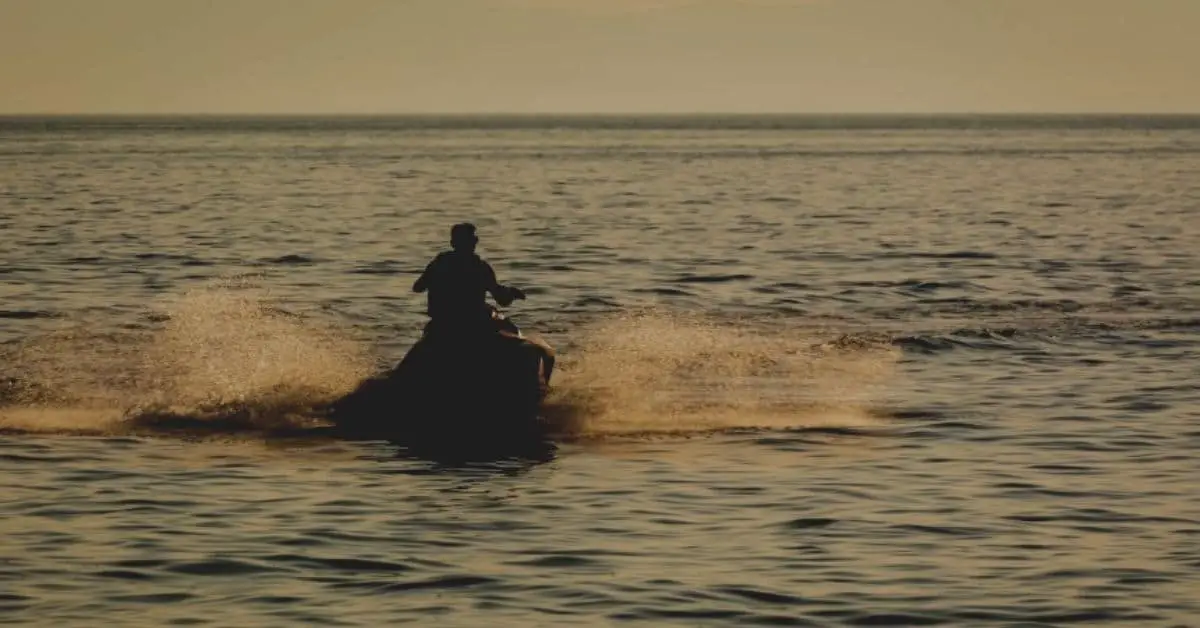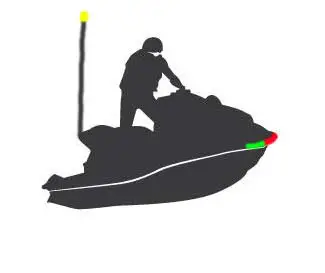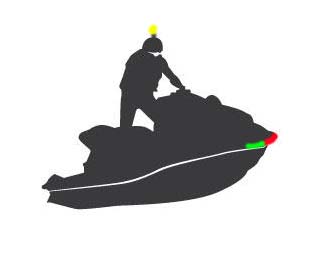As most jet ski owners know, jet skis are fun and pretty crazy. This is great during the daytime, but can you also have fun on your jet ski after the sun goes down? To answer this question, I checked the laws of every state according to the U.S. Coast Guard and this is what I found:
According to data from uscgboating.org, 41 out of 54 U.S. states and territories have laws prohibiting riding your jet ski (PWC) at night even if you have the correct navigational lights equipped. If it is legal in your state, there are restrictions put into place that you will still need to follow.
So in other words, no jet ski riding at night is not allowed in most states and even if it is allowed in your state, it’s still quite dangerous for a number of reasons.
As for other countries, I couldn’t find much but here’s all I found: in Australia, you can drive a jet ski after dark in Queensland and Victoria as long as you have proper navigational lights, but not in New South Wales and South Australia. In Spain, you cannot drive a jet ski after the sun has gone down. Unfortunately, I couldn’t find any more country’s laws on this topic.
Which states can/can’t you ride your jet ski after dark?
| State | Does this state prohibit jet skiing at any times | What are the exact times jet skiing is prohibited |
|---|---|---|
| Alabama | No | Nighttime riding is allowed with correct navigational lights |
| Alaska | No | Nighttime riding is allowed with correct navigational lights |
| American Samoa | Yes | Sunset to sunrise |
| Arizona | Yes | Sunset to sunrise and low visibility weather |
| Arkansas | Yes | 30 minutes after sunset to 30 minutes before sunrise |
| California | Yes | Sunset to sunrise |
| Colorado | Yes | 30 minutes after sunset to 30 minutes before sunrise |
| Connecticut | Yes | Sunset to sunrise and low visibility weather |
| Delaware | Yes | Sunset to sunrise |
| District of Columbia | No | Nighttime riding is allowed with correct navigational lights |
| Florida | Yes | Sunset to sunrise |
| Georgia | Yes | Sunset to sunrise |
| Guam | Yes | Sunset to sunrise |
| Hawaii | No | Nighttime riding is allowed with correct navigational lights |
| Idaho | Yes | Sunset to sunrise and low visibility weather |
| Illinois | Yes | Sunset to sunrise |
| Indiana | No | Nighttime riding is allowed with correct navigational lights |
| Iowa | Yes | Sunset to sunrise |
| Kansas | Yes | Sunset to sunrise |
| Kentucky | Yes | Sunset to sunrise |
| Louisiana | Yes | Sunset to sunrise |
| Maine | Yes | Sunset to sunrise |
| Maryland | Yes | Sunset to sunrise |
| Massachusetts | Yes | Sunset to sunrise |
| Michigan | Yes | 1 hour before sunset to 8 AM the next day |
| Minnesota | Yes | 1 hour before sunset to 9:30 AM the next day |
| Mississippi | No | Nighttime riding is allowed with correct navigational lights |
| Missouri | No | Nighttime riding is allowed with correct navigational lights |
| Montana | No | Nighttime riding is allowed with correct navigational lights |
| Nebraska | Yes | Sunset to sunrise |
| Nevada | Yes | Sunset to sunrise |
| New Hampshire | No | Nighttime riding is allowed with correct navigational lights |
| New Jersey | Yes | Sunset to sunrise |
| New Mexico | Yes | Sunset to sunrise |
| New York | Yes | Sunset to sunrise |
| North Carolina | Yes | Sunset to sunrise |
| North Dakota | Yes | Sunset to sunrise |
| Northern Mariana Islands | Yes | 1 hour after sunset to 1 hour before sunrise |
| Ohio | Yes | Sunset to sunrise |
| Oklahoma | No | Nighttime riding is allowed with correct navigational lights |
| Oregon | No | Nighttime riding is allowed with correct navigational lights |
| Pennsylvania | Yes | Sunset to sunrise |
| Puerto Rico | Yes | Sunset to sunrise |
| Rhode Island | Yes | 30 minutes after sunset to 30 minutes before sunrise |
| South Carolina | Yes | Sunset to sunrise |
| South Dakota | No | Nighttime riding is allowed with correct navigational lights |
| Tennessee | Yes | Sunset to sunrise and low visibility weather |
| Texas | Yes | Sunset to sunrise |
| Utah | Yes | Sunset to sunrise |
| Vermont | No | Nighttime riding is allowed with correct navigational lights |
| Virgin Islands | NA | Couldn’t find any information |
| Virginia | Yes | Sunset to sunrise |
| Washington | Yes | Sunset to sunrise |
| West Virginia | Yes | Sunset to sunrise |
| Wisconsin | Yes | Sunset to sunrise |
| Wyoming | NA | Couldn’t find any information |
What are all of the nighttime restrictions for jet ski riding during the night?
Jet skiing at night is completely different than during the day as it’s extremely hard to see anything around. Restrictions are put in place to keep jet ski riders and others on the water safe. So here are the restrictions:
- You can’t go over 15 to 30 mph (depends on your states law)
- You must use proper navigational lights on your jet ski
- All dayttime restrictions apply aswell obviously
So you cannot do any crazy fast driving as you would during the daytime as this is more dangerous with low visibility for you and other boaters.
How to make sure your jet ski is properly equipped with navagational lighting for nighttime riding?
Most jet skis don’t come equipped with navigational lights when you purchase them, so you are most likely going to have to put them on yourself. In order to do that you should first know exactly what kinds of lights you need and where they should go.
Sidelights: these lights go on the two sides of the jet ski. The port side (left) needs to have a red light, and the starboard side (right) needs to have a green light.
All-around white light: this white light goes on the highest point and has to be seen from all possible angles (360°) around the jet ski. On a jet ski, this either must be worn on top of your head somehow or a long metal stick that connects to the back of the ski and rises up over your head.
Here is a drawing of what it would look like:
Anything else that doesn’t follow these rules is illegal and you can be fined for it.
Check out these sidelights on Amazon. As for the all-around white light, you’re going to have to get a bit creative as you somehow have to get it to go over your head and connect to your jet ski. I’d think the easiest thing to do would be to wear it on top of your head somehow or get like a 4-foot pole that attaches to the back of your ski.
Are there any jet ski’s with navagational lights already equipped from stock that you can buy?
The Sea-Doo SAR (search and rescue) is the only model I could find that has nighttime navigational lights installed, but this is only for search and rescue teams and is generally not available for the public. If you want lights on your ski, you gotta do it yourself.
The dangers of riding a jet ski during the night
Nighttime leads to many additional dangers out on the water for jet ski riders and boaters because of the low visibility. It’s especially dangerous for jet ski riders as jet skis are small, fast, and generally more fragile than larger boats. Also, jet ski drivers tend to do a lot of stupid stuff (admit it, I do it too) which is more dangerous at night.
Here are the 8 things you need to worry about when jet ski riding at night:
- Running into floating debris that you can’t see
- Running into shallow spots you can’t see
- Running into boats you can’t see
- Other boats running into you that can’t see you
- Falling off your jet ski and not being able to spot it
- Falling of your jet ski and not being seen by other boats
- Getting lost and not knowing how to get back to where you came from
- Its much harder for a search and rescue team to find you if you get hurt or lost
In my opinion, jet ski riding at night is not worth the risk. You can have much more fun during the day, so you might as well just go out during the daytime.
What if you get stuck out on a jet ski and it starts to get dark?
If you get stuck out in the water either due to bad time management, a storm, or whatever, the best thing to do is turn on your navigational lights or at least some kind of lights and get back as quickly as you can. Being a tad late after sunset shouldn’t be that big of a deal, but if you do get stopped just hope the officer is in a good mood and you’ll probably get away with getting finned.
If you are very far away and you don’t have any lights, it might be a good idea to call a towboat. Or if you’re lucky, one of your friends who has a boat can come out and tow you home.
What are the fines like if you get cought jet skiing at night where it’s illigal?
This number can widely vary from state to state and how crazy you were driving and many other factors. The best thing to do if you get pulled over is simply be as kind and polite as you can. If you get on the officer’s bad side, you will probably be looking at a couple of hundred dollar fine and on top of that most officers will probably make you call a boat tow to get you back to shore, which costs a lot.
Can you tube, water ski, or wakeboard behind a jet ski at night?
The simple answer to this is no, you cannot tow anyone behind your boat during hours after sunset and before sunrise. This is obviously dangerous to the water skier as if fallen into the water, it would be hard to find them and would run the risk of another boater running them over.
Strangely, it is legal if you live in Alaska though, for some reason.
- What Is The Cheapest Way To Store A Boat? - February 28, 2023
- Do Boats Need Bottom Paint? (Uncovering the Truth) - February 2, 2023
- How Much Is Bass Boat Insurance? (Real Quotes) - January 18, 2023



